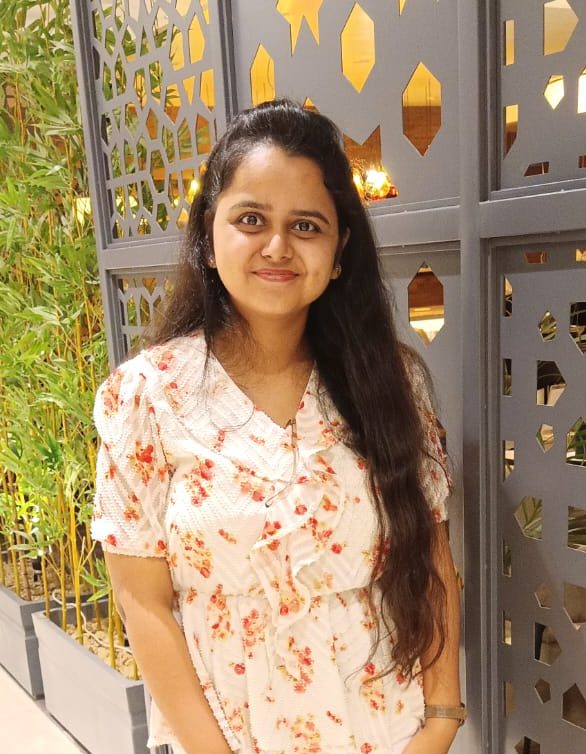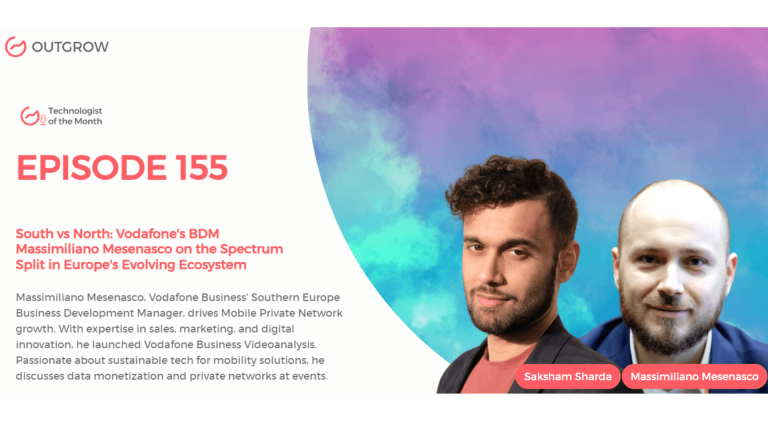EPISODE 234: Marketer of the Month Podcast with Brice van de Walle
Table of Contents
Hey there! Welcome to the Marketer Of The Month blog!
We recently interviewed Brice van de Walle for our monthly podcast – ‘Marketer of the Month’! We had some amazing insightful conversations with Brice and here’s what we discussed about-
1. Competition Driving Innovation in Payment Ecosystem Security.
2. Tokenization eliminates Manual Card Entry for Seamless Checkout.
3. Click to Pay and Passkeys Revolutionizing User Experience.
4. European Consumer Expectations for Speed, Security, and Trust.
5. Traditional Card Payments Adapting to Digital Wallet Competition.
6. Mastercard’s Partnership Strategy with Fintech Innovators Explained.
7. Balancing Security Verification with Frictionless User Experience Demands.
About our host:
Dr. Saksham Sharda is the Chief Information Officer at Outgrow.co He specializes in data collection, analysis, filtering, and transfer by means of widgets and applets. Interactive, cultural, and trending widgets designed by him have been featured on TrendHunter, Alibaba, ProductHunt, New York Marketing Association, FactoryBerlin, Digimarcon Silicon Valley, and at The European Affiliate Summit.
About our guest:
Brice van de Walle is the Executive Vice President of Core Payments Europe at Mastercard, bringing extensive expertise in the global payments ecosystem. As a passionate payments professional, he has driven transformative initiatives across multiple regions and markets, demonstrating exceptional leadership in market development, sales, product management, and business strategy.
Goodbye Card Numbers: Mastercard’s VP of Core Payments Brice van de Walle on how Tokenization Modernizes Checkouts
The Intro!
Saksham Sharda: Hi, everyone. Welcome to another episode of Outgrow’s Marketer of the Month. I’m your host, Dr. Saksham Sharda, and I’m the creative director at Outgrow. co. And for this month we are going to interview Brice van de Walle who is the Executive Vice President, Core Payments Europe at Mastercard.
Brice van de Walle: Great to be here. Thank you.
Don’t have time to read? No problem, just watch the Podcast!
Challenge yourself with this trivia about the exciting topics Brice van de Walle covered in the podcast.
Or you can just listen to it on Spotify!
The Rapid Fire Round!
Saksham Sharda: First one is, at what age do you want to retire?
Brice van de Walle: 55.
Saksham Sharda: How long does it take you to get ready in the mornings?
Brice van de Walle: 25 minutes.
Saksham Sharda: Favorite color?
Brice van de Walle: Blue.
Saksham Sharda: What time of day are you most inspired?
Brice van de Walle: Morning.
Saksham Sharda: How many hours of sleep can you survive on?
Brice van de Walle: Five.
Saksham Sharda: How do you relax?
Brice van de Walle: Hiking.
Saksham Sharda: How many cups of coffee do you drink per day?
Brice van de Walle: Too many.
Saksham Sharda: A habit of yours that you hate?
Brice van de Walle: Coffee addiction.
Saksham Sharda: The most valuable skill you’ve learned in life?
Brice van de Walle: Patience.
Saksham Sharda: Your favorite Netflix show?
Brice van de Walle: Alpha Male
Saksham Sharda: Are you an early riser or a night owl?
Brice van de Walle: Both.
Saksham Sharda: One-word description of your leadership style.
Brice van de Walle: Attentive.
Saksham Sharda: Coffee or tea to kickstart your day?
Brice van de Walle: I guess coffee.
Saksham Sharda: Top priority in your daily schedule?
Brice van de Walle: Achieve something.
Saksham Sharda: Ideal vacation spot for relaxation?
Brice van de Walle: Mountain.
Saksham Sharda: A key factor for maintaining a work-life balance.
Brice van de Walle: Think about my wife.
The Big Questions!
Saksham Sharda: Now we go to the longer questions. So you can forget the rapid fire. You can answer as much ease and time as you like. Let’s go. How is the payment landscape evolving to meet the demands of instant, seamless transactions in today’s digital economy?
Brice van de Walle: So, I would say to start with that the world of payment has become increasingly competitive with a lot of players coming into the mix. And, I guess when you have competition, that stimulates the entire ecosystem to drive innovation. And the things that are obviously mostly important to innovate on our security, as always, are key, but it’s also the user experience, and the fluidity of the payment. And with all these people coming within the ecosystem, the things that are now driving the biggest improvement in terms of the user experience and how people pay are, first of all, tokenization. I mean, we used to have quite a lot of time spent when you’re checking out on your favorite website to actually enter your card credentials on the website. And now, thanks to tokenization, you will no longer need to do that. Right. And so we’ve seen that now. So we’ve seen that tokenization has tremendously increased, and now, you know, that’s one thing. The other thing that is also getting a lot of traction is what we call pass keys. And that’s the ability for a payment solution to leverage the biometric capabilities of the mobile or the device.
Saksham Sharda: How is the payments landscape evolving to meet the demands of instant, seamless transactions in today’s digital economy?
Brice van de Walle: Okay, so I guess there’s one big trend, which is the tokenization of card credentials. In the past, we used to have to enter our PIN number, our card number into our favorite website to check out. And that was very long, very painful. And, thanks to tokenization, we no longer need to do that. And so that is true in two cases, it’s true when consumers or Car Lauder are storing their car details into a merchant where they will purchase regularly from them. So it could be a car-sharing app. It could be your favorite marketplace, or it could be a movie streaming company. So that’s the regular subscription recurring payment part. And so we call it a secure card on file. So that’s one part where tokenization is extremely useful.
Brice van de Walle: And the other use case is what we call guest checkout, right? So when you’re not actually a consumer willing to store your card credentials at the merchant, but that doesn’t mean that you don’t want to have a good experience. And again, here, tokenization combined with click to pay, which is the e and v code standards to allow fast and seamless payment, you are actually improving the user experience. Now, if you add one more component, and that is something which is really gonna blow up quite rapidly in Europe, and which is the PA keys, which is a technology that leverages the biometric capabilities of your smartphone, of your tablets or computer that you’re using to perform a purchase without having you to go and be redirected to a separate app or use a one-time password that is basically creating friction and, and, and lower a conversion rate. Now with PA Keys, you’re just gonna have a, a much seamless, much more seamless experience to check out. So you combine that with click-to-pay mpa keys, and you know, you’re gonna see a tremendous improvement on the approval rate overall. So a lot of exciting stuff is coming ahead of us.
Saksham Sharda: So, do you feel consumer expectations differ across European markets when it comes to payment speed and convenience?
Brice van de Walle: I would say no. I mean, overall, consumers all want speed, security, and trust, right? And, this is why we’re consistently working across those three dimensions across all the European markets and actually across the world.
Saksham Sharda: So, with the rise of digital wallets and alternative payment methods, how is the traditional card-based payment model adapting?
Brice van de Walle: I think, I mean, first of all, we welcome competition, right? And because this is helping us to innovate, and is ultimately benefiting both the merchants and the consumers. Now, what we’ve seen, and we actually have a lot of partnerships with, with those alternative payment methods, whether they’re local or regional, whether they’re European or global. And, we see that we have things to offer. So the typical use case that we see is when we enable some of these purely online alternative payment solutions to work in the physical world, right? We’re leveraging NFC, we’re leveraging contactless technology to enable their customers to actually pay and use the MasterCard contactless acceptance infrastructure. So we actually, of course, compete, but we also partner with them and enable new use cases for them. So all good.
Saksham Sharda: And how do you see the competitive landscape evolving between traditional payment networks and fintech innovators?
Brice van de Walle: So, FinTech innovators, and again, we’ve been partnering with many, many fintechs for many years because they are bringing the innovation. And so we are helping them to actually make sure that they can provide the best-in-class experience. So we actually really enjoy working with them. And this is obviously creating, at the end of the day, a benefit for consumers. So again, something that we feel very happy about, and there will be more, and there will always be more. And I think that’s what makes this payment business so exciting.
Saksham Sharda: Mastercard has set an ambitious goal to phase out manual card entry and reach 100% tokenization in Europe by 2030. From your strategic perspective, what’s driving this momentum, and how are you working with partners to maintain this pace?
Brice van de Walle: Okay, so I think we issued that statement or that vision last year, where we would have a hundred percent of tokenized transactions or car-not-present transactions in Europe for a very specific reason. First, we wanted to make sure that we couldn’t maintain the fraud levels at the lowest possible level because we know that tokens are actually preventing fraud from happening, but also because they help us improve, together with the issuers, the approval rate, right? So that’s ultimately benefiting the merchants. And so we’ve put that aggressive goal so that everybody in the ecosystem, merchant issuers, acquirers, PSPs, pay facts, you name it all, understand where we want the ecosystem to go, because we all have obviously a big incentive to reduce fraud and increase approval rates. And, now we’ve almost reached a year of working on this half of the transaction, right, to be tokenized? So, we are very happy about that. We had a bump of about 30% versus last year, which is amazing. And this is thanks to the work that we’ve been doing together with our partners, right? Without the issuers there, acquirers emerging from the PSPPs, we would not have been able to get there. So it’s a fantastic partnership across the ecosystem to make it happen. And given where we are today, we are very confident that by 2030, we’ll actually reach that goal of a hundred percent tokenized content, present transaction.
Saksham Sharda: Based on your stakeholder relationship experience, what are the biggest challenges you face in getting merchants and financial institutions aligned with this tokenization roadmap?
Brice van de Walle: I think again, the biggest challenge is always to get the ball rolling at the beginning because you need to make sure that everybody’s aligned on that vision. But, in that particular case, I’m very confident because you have a benefit, which is fraud reduction, and approval rates increase, which is something that everybody in the ecosystem is looking for. So there, there’s no misalignment there. And the fact that we already have almost 50% or half of the transaction tokenized means that you know, the ecosystem has already adopted it. So I think it’s gonna be about making sure that the merchants and the PSPs that have not yet adopted, that you know, get an upgrade together with their PSPs with their banks so that they can also enable that use case.
Saksham Sharda: Consumers are increasingly frustrated with checkout friction in their payment experiences. From your perspective, how are solutions like passkeys and Click to Pay helping tackle these pain points, and what does your vision of a truly seamless digital payment experience look like?
Brice van de Walle: Right. So, as I mentioned before, if you combine a check to pay with task use, you can basically provide a completely seamless checkout experience. So no need to reenter your name, your card number, your CVC, or your expiry date. So that’s clearly something that has been traditionally taking a lot of time when you’re checking out. And if you add to that task keys, which are leveraging the biometric of your device that you’re using for the checkout, you’re also improving the user experience because you don’t need to rely on a one-time password or another device or another application to authenticate yourself. So if you combine the two together, then you’re basically limiting to the minimum the time that is required for you as a consumer to check out from your favorite website.
Saksham Sharda: And how do you balance the need for security verification with the demand for frictionless user experiences?
Brice van de Walle: Good question. So again, tokenization is the way for us to prevent fraud. The fact that the tokens are uniquely attached to a specific merchant or a specific use case allows us to control how these tokens are being used. So, to give you an example, if you have a token stored at your favorite let’s say ride-sharing app, and someone is able to capture that token and try to reuse it at another merchant, it’s simply not gonna work. So that’s a way for us to reduce fraud drastically.
Saksham Sharda: The B2B payments space has traditionally lagged behind consumer payments in terms of innovation. What’s changing in this sector?
Brice van de Walle: I think the B2B space has always been an area where the complexity of the ecosystem and the use cases made things a little harder to happen. Now, what we see at MasterCard is the incredible increase in interest in stablecoin that will allow money to move much faster. It will allow people who are dealing with the treasury to do things that they were probably struggling a little bit with in the past. And, it’s just gonna get the flows going much faster, much further than it used to. Now, the things that we are obviously trying to work on in parallel, while, you know, the stable con is clearly enabling new use cases, is to make sure that we maintain customers and there could be B2B, of course, customers trust into the ecosystem, making sure that security remains paramount because that’s you know, the essence of the payment business. So, we will have, even though you have a lot of innovation, a lot of new use cases that are coming, we will have to make sure that those fundamental principles around security and trust remain true at all times.
Saksham Sharda: So let’s pivot to a different kind of question now. What does your typical day look like? You wake up in the morning, how many meetings do you have? How much of your time is taken up by meetings? What do you do?
Brice van de Walle: Usually, I start my meetings around 8:30 or 9:00, and then my day is usually full of meetings until 6:00 PM, so hopefully I have a bit of a lunchtime. But that’s not always a given.
Saksham Sharda: Customer education plays a crucial role in payment adoption. How do you effectively communicate the value of new payment technologies to different audiences?
Brice van de Walle: As a B2C organization, the most important thing that we have to do in order to communicate to the end consumers is to make sure that our partners, the issuers right, the banks that are putting the cards in the hands of the consumers, whether it’s a physical or digital card, truly understand all the benefits that the MasterCard can bring to those consumers and are empowered and enabled to communicate those values to the end consumer. So we work very closely with our banking partners so that they have all the materials, all the information that they need in order to communicate the value prop to the end consumers.
Saksham Sharda: I guess brand differentiation in payments is challenging when the core functionality appears similar. How do you create compelling value propositions in this space?
Brice van de Walle: So, you’re right. I mean, this is certainly one of the key focuses for us to differentiate. We want not only merchants to prefer MasterCard to other payment solutions, but we also want issuers and cardholders to understand the clear benefits that they’re getting from their MasterCard, right? As opposed to other schemes. So the way we are doing this is by investing a lot of our time and working really hard to identify assets that will resonate with our consumers, with our car loaders, right? And so the thing that we are launching now is the MasterCard collection, which is basically a wrapper that encapsulates all the different benefits that we will be able to provide through our issuers to the cardholders. Those assets will be around all the things that really matter. And we’ve been doing a lot of surveys around the world to understand what consumers need and want when it comes to those kinds of benefits. And it’s all around entertainment, dining, and the last one is traveling. And so we are packaging all these benefits, and we are curating those experiences and making them available through one single API for the issuers so that the issuers can basically deliver those benefits in a consistent global manner to the end consumers.
Saksham Sharda: Looking about the future, then, what payment innovations do you believe will have the most significant impact on how people and businesses transact?
Brice van de Walle: So, I obviously don’t have a crystal ball, but I think one of the things that will tremendously change the way we operate as consumers is the emergence of AI. We recently announced the possibility for an AI agent to perform a purchase, right? In the past, or in the last, let’s say 1824 months, AI agents have been increasingly improving in what they can do for you as a consumer. The number of things you can find, the information you can get about anything you want, is just mind-blowing. But the last mile, which is, how do I actually pay for whatever I’ve been searching for through the AI agent, was always missing, right? And now with what we’ve been announcing and the possibility for an AI agent to rely on tokenization, to rely on our technology to be part of the ecosystem, we will then enable that sort of last-mile component, which is the payment. And we can foresee that over time, consumers might actually change their behavior in a much more drastic way. IE, instead of going and doing their shopping on the most well-known website, as we know it today, they might even go straight through those agents and perform the entire purchasing process through them. So I think that’s gonna be a fundamental change, but we’ll see. Let’s see.
Saksham Sharda: So the last question for you is of a personal kind. What would you be doing in your life if not this?
Brice van de Walle: Sailing.
Let’s Conclude!
Saksham Sharda: Thanks, everyone for joining us for this month’s episode of Outgrow’s Marketer of the Month. That was Brice van de Walle who is the Executive Vice President, Core Payments Europe at Mastercard
Brice van de Walle: Great to be here. Thank you.
Saksham Sharda: Check out the website for more details and we’ll see you once again next month with another marketer of the month.

Muskan is a Marketing Analyst at Outgrow. She is working on multiple areas of marketing. On her days off though, she loves exploring new cafes, drinking coffee, and catching up with friends.








